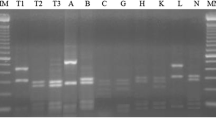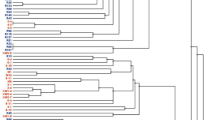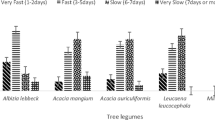Abstract
A total of 98 rhizobial strains, isolated during the winter of the years 2003 (35 isolates), 2004 (33 isolates), and 2005 (30 isolates) were analyzed to determine the genetic diversity of the natural population nodulating Vicia faba plants and to identify dominant genotypes. All isolates were identified as Rhizobium leguminosarum bv. viciae by biovar-specific polymerase chain reaction amplification of the nodC gene. Intraspecific DNA polymorphism was evaluated through the restriction endonucleases analysis combined with pulsed-field gel electrophoresis. Four genotypes characterized 53% of the isolates, showing a high occurrence; moreover, they were recovered over the 3 years, thus showing a lasting persistence in the soil, which could mean a high degree of saprophytic competitiveness. The richness, diversity, and dominance indexes of genotypes were calculated to monitor the evolution of the rhizobial population during the 3 years. The genetic diversity of the analyzed strains decreased along the 3 years. In fact, the biodiversity index H′ decreased from 2.6 in the first and second year to 1.9 in the third year; probably, as a result of bean monocropping, specific genotypes of Rh. leguminosarum bv. viciae were naturally selected.


Similar content being viewed by others
References
Allen ON, Allen EK (1981) The Leguminosae: A source book of characteristics, uses and nodulations. Macmillan, London
Carelli M, Gnocchi S, Fancelli S, et al. (2000) Genetic diversity and dynamics of Sinorhizobium meliloti populations nodulating different alfalfa cultivars in italian soils. Appl Environ Microbiol 66:4785–4789
Corich V, Giacomini A, Ollero FJ, et al. (1991) Pulsed-field electrophoresis in contour-clamped homogeneous electric fields (CHEF) for the fingerprinting of Rhizobium spp. FEMS Microbiol Lett 83:193–198
Corich V, Giacomini A, Carlot M, et al. (2001) Comparative strain typing of Rhizobium leguminosarum bv. viciae natural populations. Can J Microbiol 47:580–584
Depret G, Houot S, Allard M-R, et al. (2004) Long-term effects of crop management on Rhizobium leguminosarum biovar viciae populations. FEMS Microbiol Ecol 51:87–97
Graham PH, Sadowsky MJ, Keyser HH, et al. (1991) Proposed minimal standards for the description of new genera and species of root- and stem-nodulating bacteria. Int J Syst Bacteriol 41:582–587
Hooykaas PJJ, Clapwijk PM, Nuti MP, et al. (1977) Transfer of the Agrobacterium tumefaciens Ti plasmid to avirulent Agrobacteria and to Rhizobium explanta. J Gen Microbiol 98:477–484
Laguerre G, Louvrier P, Allard MR, Amarger N (2003) Compatibility of rhizobial genotypes within natural populations of Rhizobium leguminosarum bv. viciae for nodulation of host legumes. Appl Environ Microbiol 69:2276–2283
Lupwayi NZ, Stephens PM, Noonan MJ (1996) Relationship between timing of infection and nodulation competitiveness of Rhizobium meliloti. Appl Environ Microbiol 69:2276–2283
McClelland M, Jones R, Patel Y, Nelson M (1987) Restriction endonuclease for pulsed field mapping of bacterial genomes. Nucleic Acids Res 15:5985–6005
Moschetti G, Blaiotta G, Aponte M, et al. (1998) Random amplified polymorphic DNA and amplified ribosomal DNA spacer polymorphism: powerful methods to differentiate Streptococcus thermophilus strains. J Appl Microbiol 85:25–36
Moschetti G, Peluso AL, Protopapa A, et al. (2005) Use of nodulation pattern, stress tolerance, nodC gene amplification, RAPD-PCR and RFLP-16S rDNA analysis to discriminate genotypes of Rhizobium leguminosarum biovar viciae. Syst Appl Microbiol 28:619–631
Mutch LA, Tamimi SM, Young JPW (2003) Genotypic characterisation of rhizobia nodulating Vicia faba from the soils of Jordan: a comparison with UK isolates. Soil Biol Biochem 35:709–714
Priefer UB (1989) Genes involved in lipopolysaccharide production and symbiosis are clustered on the chromosome of Rhizobium leguminosarum biovar viciae VF39. J Bacteriol 171:6161–6168
Saitou N, Nei M (1987) The neighbour-joining method: a new method for reconstructing phylogenetic trees. Mol Biol Evol 4:406–425
Silva C, Vinuesa P, Eguiarte L, et al. (2003) Rhizobium etli and Rhizobium gallicum nodulate common bean (Phaseolus vulgaris) in a traditionally managed milpa plot in Mexico: population genetics and biogeographic implications. Appl Environ Microbiol 69:884–893
Vincent JM (1970) A manual for the practical study of root. nodule bacteria. IBP Handook 15. Blackwell, Oxford
Acknowledgment
This research was supported by a grant from the Ministero delle Politiche Agricole e Forestali (MIPAF, Rome) within the Programme “Genetic resources of organisms useful for the improvement of agricultural species and to a sustainable agriculture.”
Author information
Authors and Affiliations
Corresponding author
Rights and permissions
About this article
Cite this article
Ventorino, V., Chiurazzi, M., Aponte, M. et al. Genetic Diversity of a Natural Population of Rhizobium leguminosarum bv. viciae Nodulating Plants of Vicia faba in the Vesuvian Area. Curr Microbiol 55, 512–517 (2007). https://doi.org/10.1007/s00284-007-9024-5
Received:
Accepted:
Published:
Issue Date:
DOI: https://doi.org/10.1007/s00284-007-9024-5




